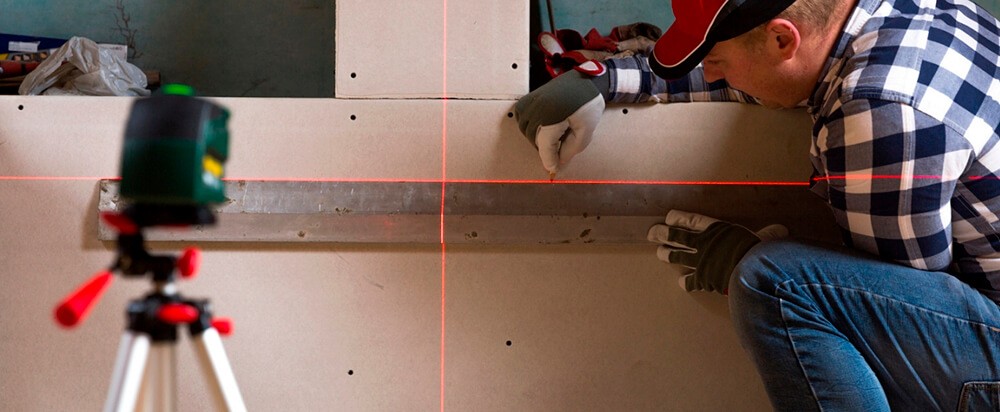
There are tons of tasks the best laser level can make easier and faster to perform. Building the mathematical model, drawing the tile squaring, hanging shelves or paintings, and fitting drop ceiling are just a few of them. Still, each task has its difficulty level and specifics requiring a specific tool.
The laser levels differ by many parameters. Below are the ones to consider before picking a device for professional or DIY needs.
- A number of beams. If you’re planning on hanging cabinets or drawing the windows, the single or double beam level will do. However, for construction, piping works, drawing of the furniture layout the three-beam laser level will be much more helpful.
- Throw distance. For indoor works, the 30 ft laser beam is enough for the majority of tasks. However, in large rooms or for outdoor projects, the line of 100 ft and longer might be required.
- Accuracy. The laser levels can have different accuracy and thus, different efficiency. ⅛-inch is considered standard pro-grade accuracy.
- Weight. The lightweight models fit the height works, while the sturdy ones usually provide more stability and accuracy.
- Installation mechanism. While most laser levels require a straight surface (like a tripod) for installation, others can be fitted almost everywhere due to magnetic and clamping mechanisms.
- Power. Power supply from mains or replaceable batteries. For different tasks and locations, each type can be preferable.
Laser Level Reviews
DEWALT DW088K — Our Top Pick
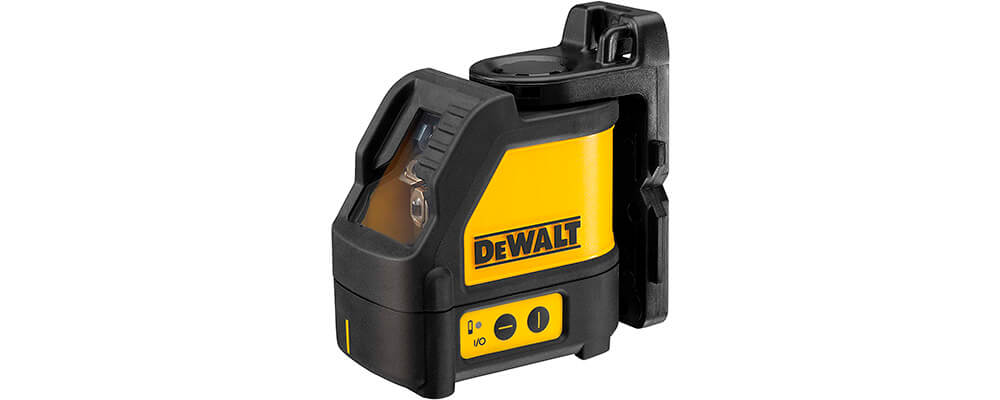
A self-leveling mechanism, pin-point accuracy, and optional range extension would grant this device to claim a title of the best laser level on the list. However, the absence of a rotation mechanism limits its usage for large-scope projects.
The Dewalt laser level emits bright red beams that are well visible indoors even at the bright illumination. It’s fully discernible at 50 ft. However, the visibility deteriorates swiftly in the direct sunlight. The solution can be an incorporated pulse mode. It’s constantly on and can reach the detector at as long as 165 ft.
The laser level self-levels within 4 degrees sparing the user the hassle of making a fully even base for it. Once the level is off for more than 4 degrees, the tool emits a characteristic beep warning the user to adjust the level.
The tool is versatile covering a wide range of DIY and professional work due to the vertical and horizontal leveling. Window framing, home gallery installation, floor tiling, etc. can be performed with ease thanks to the precise mapping.
Another great feature of this laser level is its solid base and well-fitting sticking mechanism. The powerful magnet clings reliably to a metal ladder or a metal beam not letting the level tool slide or incline. For the non-metal environment, there is a hole allowing it to hang the level on a nail or a hook.
Pros
- Individual controls for each beam — to fit the task precisely.
- Very lightweight (up to 1 pound), easy to carry along, and manipulate.
- Rugged housing, with water and debris protection.
Cons
- No pendulum lock incorporated.
- The vertical line can shake wacky if the device isn’t centered precisely.
Tavool T02 — Best Laser Level for Hanging Pictures
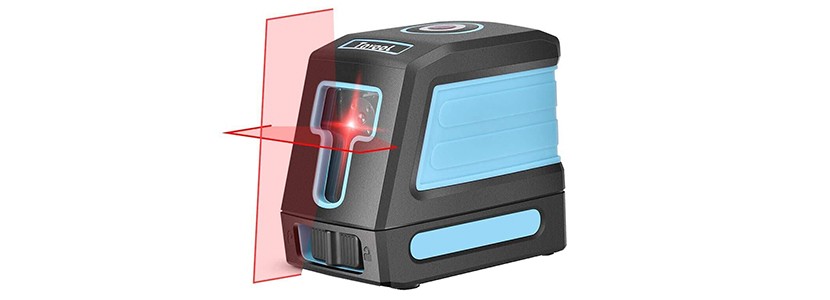
Enhanced protection, easy-to-use design, and affordable cost let this device be listed among top-rated laser levels. It offers many options present in more expensive models and has simplified controls for fast and correct operations.
The laser level has a reliable sensor system that automatically puts the beam on level / plumb. This is true for all positions under a 4-degree variance. Should the tool deviate more than 4 degrees, it will flash to show the misplacement.
The device projects a horizontal and vertical line simultaneously or separately. Mode switching as well as turning the level on/off is performed by pressing a single button, which is a handy feature.
The T02 is equipped with the pendulum lock letting use it on slopes, for angled applications, etc. The beams are traced precisely up to 50 ft and do not get blurred or blink. At the same time, in direct sunlight, the lines can be poorly visible.
The tool features a solid build and is secured from different types of hazards. It can be used in different conditions including rain, wind, dusty environment, etc. It’s also damage-proof and doesn’t need debugging if being shaken or having fallen on the ground.
Pros
- Highly accurate, fit for tiling and construction works.
- Small and lightweight, it’s easy to carry along and adjust.
- The set of four AAA batteries ensure 15 hours of constant operation.
Cons
- The level can’t be turned off in the unlocked pendulum mode.
- No automatic shut off function.
Tacklife SC-L01-50 — Best Laser Level for Home Use
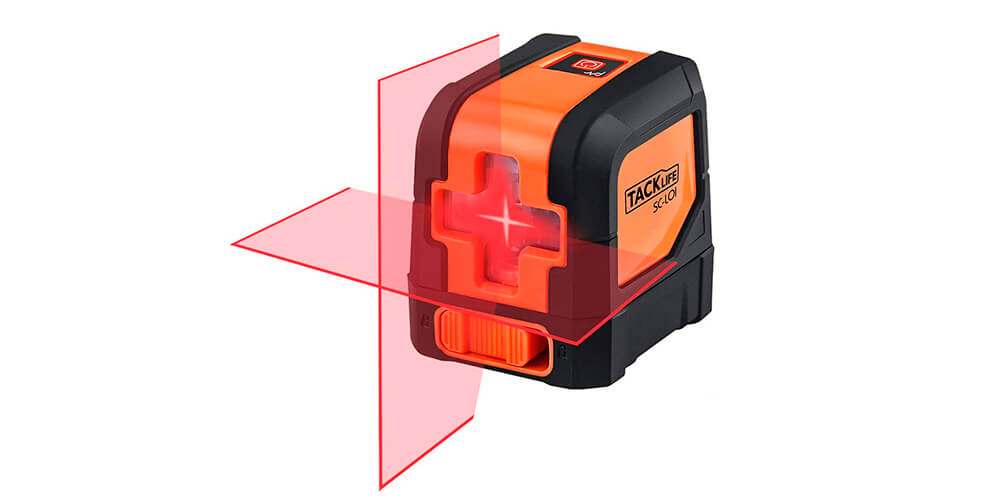
The full kit includes the cross- and straight-line laser level and magnetic base, two AA batteries, bag, manual, service card for its secure installment in different conditions. It’s notable for the large coverage area both horizontally and vertically.
This line laser is precise within 1/8 of an inch at 30 feet, can be used indoors as well. Its laser wavelength is 635±5nm, leveling accuracy is ±1/8 inches, at 30 ft, horizontal and vertical accuracy — ±1/8 inches, at 30 ft, leveling/compensation range is 4°±1°.
The device automatically levels itself, while locking the pendulum once being turned off. It creates a red laserized cross if it is within 4 degrees on either side of true zero. Besides, the laser will blink repeatedly until the level itself is aligned. Thus, it is a good option for beginner users, securing the tool from decalibrating and establishing the optimal operation mode without the user’s assistance.
This self-leveling laser level can be placed on a tripod or attached to the steel surface as well due to a 1/4-inch thread magnetic bracket on the device. There’s also an option for locking the pendulum while the laser stays on. This fits all the on-slope applications and can be used for room mapping, upholstering the angled surfaces, etc.
Pros
- Laser is so bright that can be used in low lid places.
- Very precise in self-leveling mode.
- he magnetic base holds the device firmly.
Cons
- Too bright sunlight outdoors may make the laser barely visible.
- Sensitive to vibrations.
HYCHIKA LL-2R10C
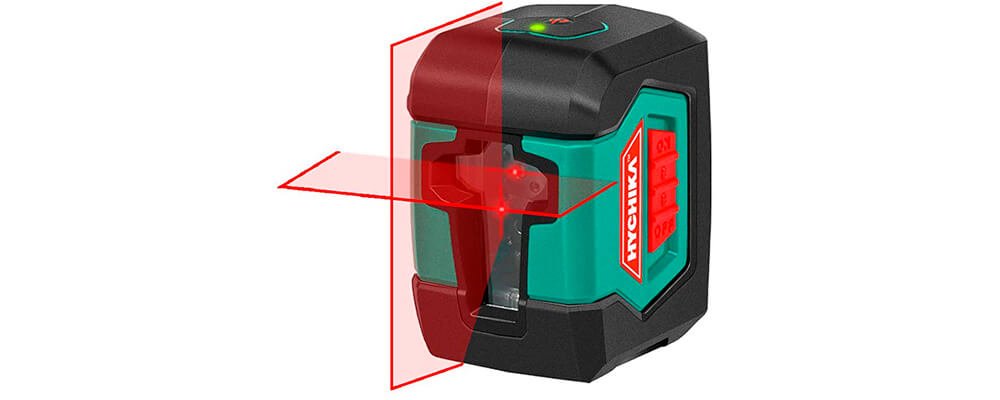
The laser line level itself is equipped with dual laser modules. The projected lie can be placed in three positions: vertical, horizontal, or like a cross. The device can work in two modes. The first one will be perfect for beginners, that is a self-leveling mode. The tilt angle is ≤ 4 °. It will adjust itself automatically, and something is wrong, it will show, constantly blinking. On the other hand, if you have to be 100% in level accuracy, press the side switch to activate the manual mode and fix lines by yourself.
The level laser width is 3mm thick, measuring distance is 50 ft, and accuracy is 1/8 inches at 30 ft.
Before start working with the LL-2R10C, you should place it onto a 1/4-inch tripod, thus the result will be the most accurate. You can freely turn it around at any angle. Moreover, if you don’t have a tripod, stick the device to the metal with the help of a magnetic bracket that is included in the kit.
The HYCHIKA is a cordless device that uses two 1.5V AA batteries. The kit also includes a cloth bag and user manual.
Pros
- The auto-leveling takes no more than 4 seconds.
- The laser managed to cover even large rooms.
- The alarm sound appears when the lines are not level.
Cons
- The magnetic bracket has no holes or clamps for hanging. You should make it by yourself.
- Weak to use it outside.
Makita SK104Z — Best Laser Level for Builders

Sturdy build, bright laser beam, and quick leveling make this tool popular among builders and contractors. Still, for the high price, it is offered, the competing models usually provide more versatile options.
This Makita laser level is made for heavy-duty jobs; so, it might be an overkill for a homeowner. It features a rubberized molding and deep laser emitting windows; so, occasional drops and hits aren’t an issue for it. It’s also water- and dustproof and can be used in various working conditions.
The level projects two bright lines and allows varying between vertical, horizontal, and crossing beams. The lines are bright and can be traced easily indoors up to 50 ft distance, without blurring or widening.
The device establishes / restores the level fast and accurately. It provides stable fully aligned lines within seconds, with high accuracy. The ⅛-inch precision is valid for both vertical and horizontal beams within 30 ft distance. The balance is restored automatically when the laser level is within 4 degrees of incline. For usage on slopes, it can be switched to the manual mode with pendulum lock activation.
Pros
- Large fan out coverage (above 240 degrees), without loss of accuracy.
- The handy side switch is easy to reach and turn to shift between the modes.
- A strong magnet in the mounting bracket holds the laser firmly at metallic objects.
Cons
- Limited instructions, no pulse mode description.
- Larger and heavier than competitors.
Klein Tools 93LCLS — Best Laser level for Homeowner

Wide range of applications thanks to added plumb spotting option, 360-degree coverage due to the pivoting mount, and high accuracy justify this model as a professional laser level. At the same time, the simplicity of use and middle-range cost make it a good option for a homeowner or DIY-er.
Projecting cross beams or separate horizontal and vertical ones, this level can assist in such tasks as deck building, room mapping, shelves hanging, drop ceiling installation. It has a wide coverage area and good brightness, throwing clear thin lines to the distance of 50 ft indoors. The plumb spotting laser displays a precise 90-degree plumb, which is useful during piping works and HVAC installation.
The tool is equipped with the sensor for automatic self-leveling. This feature can be turned off for safe carrying around. The device can be turned for 360 degrees because of the easy-to-turn magnetic bracket or can be installed onto 1/4-Inch or 5/8-Inch tripod mounting threads; thus, covering various parts of the room / worksite.
The laser level has a rugged case made of thick plastic and sustaining minor drops and hits. It has an IP54 protection class and can be used at dusty and humid locations.
Pros
- Thin precisely aligned beams, well visible even in the fluorescent light.
- Bright plumb spot, easy to see on both matte and glass surface.
- Ceiling clamp allows placing the level right under the ceiling for wider coverage.
Cons
- Heavy weight makes the magnet bracket slide down on non-all metal surfaces.
- Tight battery clip, difficult to open and replace batteries.
DEWALT DW088LG — Best Outdoor Laser Level

Fast balance restoring, easy-to-handle design, and the green beam of enhanced visibility let this outdoor laser level claim the position of the most accurate laser level. Still, its large size and considerable price make it an overkill model for regular homeowner needs.
The level emits a green line, which is precisely tracked indoors for the distance up to 100 ft, with total visibility reaching 200 ft in the relatively dark environment. For outdoor applications, the line is traced well for at least 10 ft (30 ft on a cloudy day), while the overall reaching distance can be improved with using the laser detector. The device has the pulse mode turned on permanently, not requiring any additional installation, and thus, well fits siding works and similar to it projects.
The green laser level gets leveled automatically and within seconds. For safety, it’s equipped with the pendulum lock preventing the harm to the device while off-level. The tool is made sturdy, with thick over-molding and strong glass for the laser window. The Dewalt green laser level is protected against water and debris intrusion, as well as against occasional drops and damage.
The 12V battery installed lets the level operate without losing the brightness and accuracy for several hours. It’s quickly replenished and is cost-saving for long-term usage conditions.
Pros
- Various installing brackets, for different locations and tasks (a ceiling clamp, wood screw, magnet).
- Strong magnets attach the device firmly to metallic surfaces.
- Handy well visible battery indicator.
Cons
- It doesn’t fit for angled applications, as the pendulum lock is a turn-off switch.
- The beam is a bit thicker than competing red laser models.
Bosch GLL 55
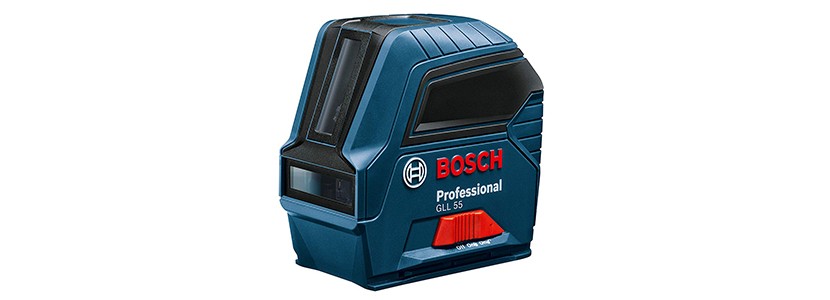
Enhanced line visibility, accurate self-leveling, and automatic lock securing the pendulum during transportation make this tool popular. It has a wide array of usage areas and tasks performed.
The VisiMax technology worked out solely by Bosch, makes for high visibility of the lines, even in the bright light. The beam is tracked easily with a human eye at its full length helping estimate the level and plumb on the spot, without having to move along the workplace. This feature might be quite helpful for big projects requiring a precise on-the-spot estimation (doors alignment, furniture mapping, etc.).
There are two beams projected – the plumb and level one. Each one can be displayed solely or both together, which is optimal for squaring. Both lines are steady and precise, thanks to self-adjusting technology. The tool signals once it’s off level, by flushing the relevant LED lights.
The Bosch laser level operates in automatic and manual mode and can be used for the specific task like angled measurement and leveling. The maximum line laser visibility is up to 50 feet in regular working conditions. The pendulum lock allows fixing positions of the beams and puts the device at any degree enabling the exact mapping of tiling or other works on the sloped surfaces.
Pros
- High accuracy (⅛ inches) within 33 ft distance.
- The diode monitoring mechanism of the Bosch laser levels allows saving power while keeping the line well visible.
- Damage- and pollution-free design, water- and debris-resistant.
Cons
- The laser beam blinks when in the “locked” position.
- The activation button is a bit stiff.
Buyer’s Guide
Laser Level: Quick Overview
A laser level is a tool made to save you from manually measuring the level line and drawing a chalk line along. These devices project the visible line or a dot onto the surface establishing the “gold standard” for leveling or plumbing.
Many modern laser levels are self-leveling and don’t require the manual setting. It means that the device has a sensor that automatically sets the level and projects the laser lines with precision. The lines can be of red or green color. While the red line is considered to be thinner, the green one is better visible and can be traced within longer distance.
The laser beams are produced by diodes that vary in brightness. They are designed for occasional DIY work are usually well visible while within a room but deteriorate quickly outdoors. The large expensive professional models project very bright lasers that are well traced even in the direct sunlight.
How to Use a Laser Level
Here are the steps to take when using the laser level:
- Read the manual. Find out what your device can and cannot do. Check if you know all the switches and their function. See if the battery is full and the charge is enough for the task you intend to perform.
- Get prepared. Think beforehand where the laser level should be put and if additional appliances (a tripod, a pole, a laser detector, laser glasses) are needed.
- Set the laser level on a floor, deck, tripod, or another flat surface or screw it to the wall, mount on the pole, ceiling, etc.
- For manual device, regulate the bubble vials until they are level.
- Activate the level. For the automatic laser level, wait for a while for the level to be established.
- The laser line or a dot appears on the surface the laser faces. With the rotary laser levels, the line will be on each horizontal or vertical surface around the level.
- If you need to use the laser level on a sloped surface, you’ll need the level with the pendulum lock option. Switch the level into the “Lock On” mode while on a flat surface, and then establish it on the angled one.
- If using the laser level outdoors, you might need a detector to level through the long distance. For that, turn on the level into the pulse mode and move the detector until it beeps signaling the level is installed. Take the necessary measurements.
How does a Laser Level Work?
The laser level uses the electricity (usually supplied by batteries) to power up the diodes that emit the beam of light, which goes straight horizontally or vertically. Focused by means of the small mirrors, these beams form a laser line that can be visible by a human eye.
There are two types of lines emitted by the laser levels: the red and green ones. While the red one is thinner and enables more accurate level measurement, the green beam is four times brighter and can be used for the wide array of outdoor applications.
Depending on the level type, it can establish the level or plumb via the vials with spirit (manual level, requires setting by the user) or by means of a sensor measuring the balance. When the level is set, it produces lines parallel (horizontal) and perpendicular (vertical) to the earth’s surface. These lines serve as the basis for measurements, mapping, etc.
If the self-leveling device is set off level, it can lead to the damage to its internal components. To avoid that, many laser levels are equipped with the pendulum lock system not letting the mechanism get uncalibrated when carrying the laser level around or changing its location.
